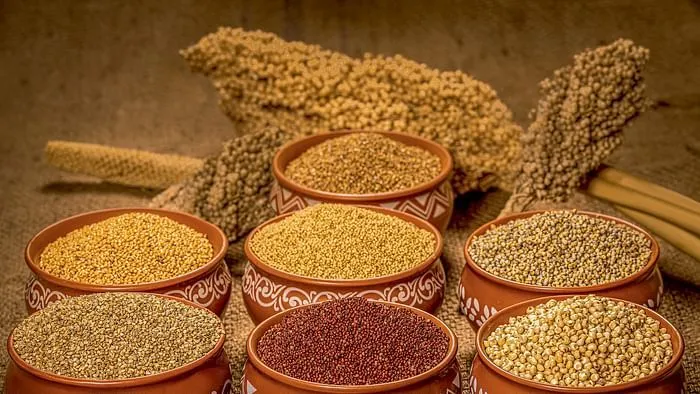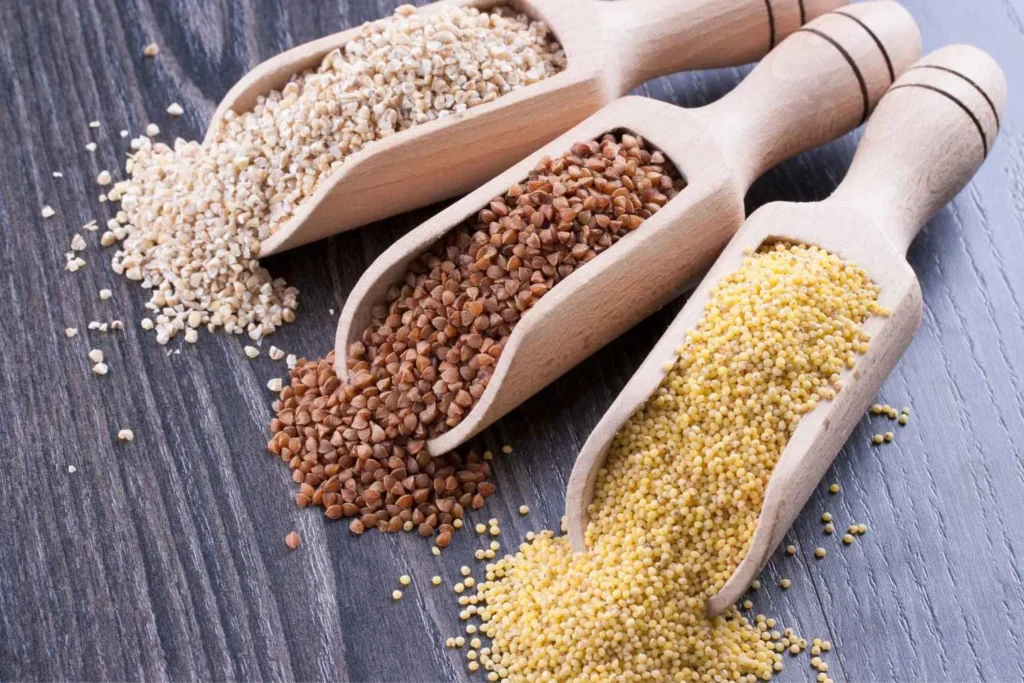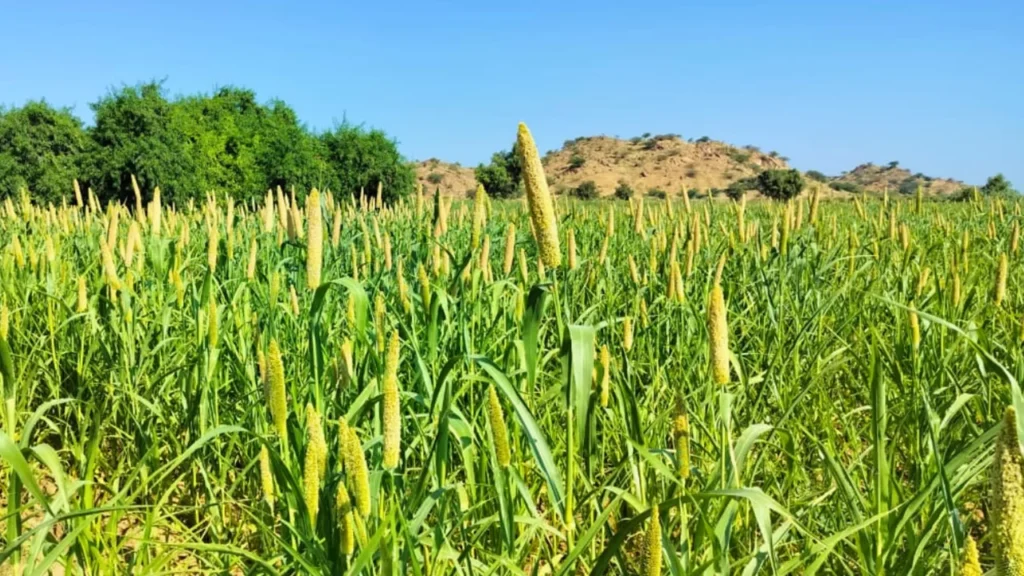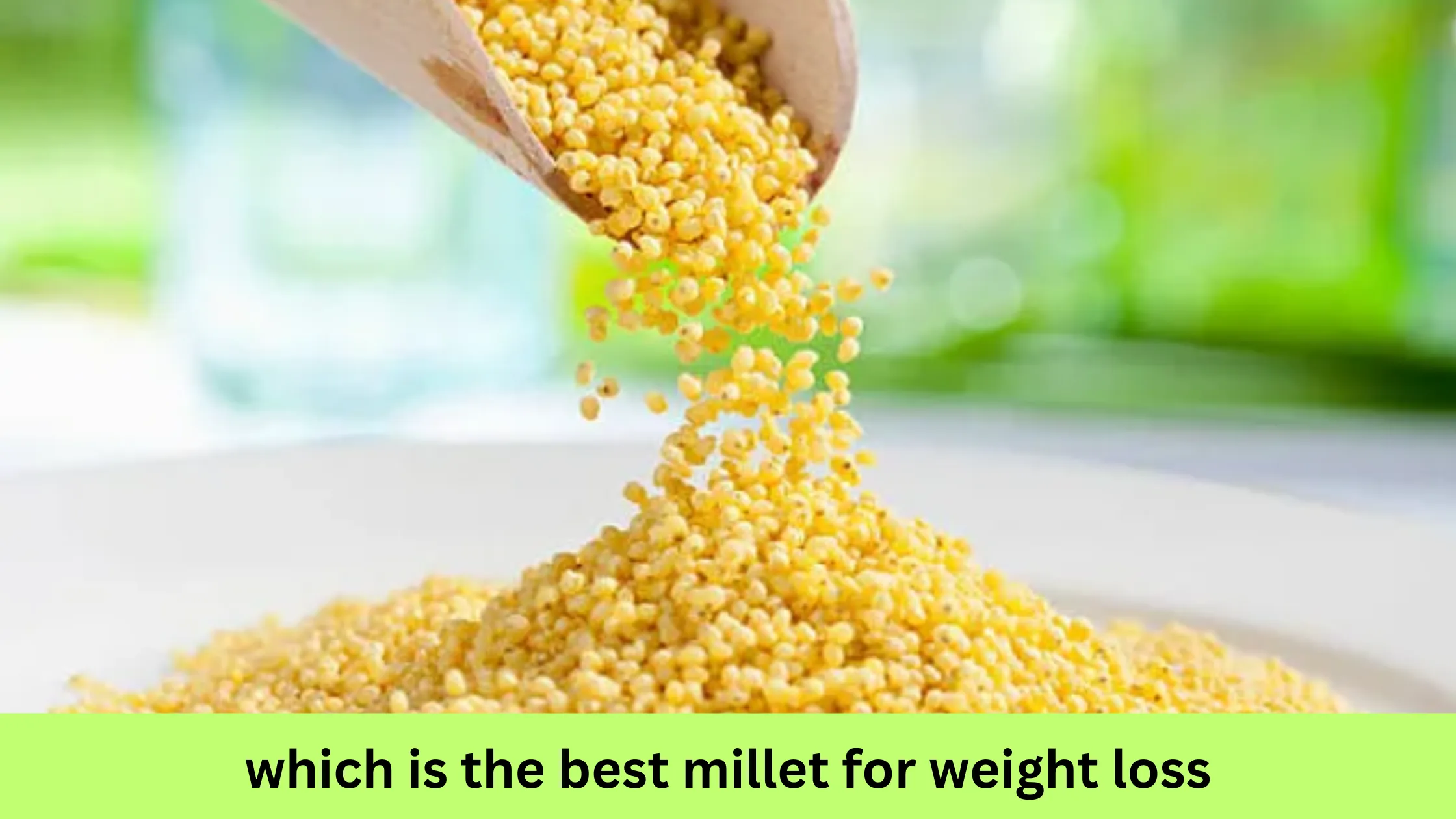If you’re trying to lose weight but still want to enjoy healthy, satisfying meals, millets might be your new best friend. These small, nutrient-packed grains have been around for thousands of years, but they’re making a big comeback—especially for people looking for natural ways to manage their weight.
Millets are often called a “superfood” for good reason. They’re packed with fiber, protein, and essential nutrients, all while being naturally gluten-free. Whether you’re trying to shed a few pounds or maintain a healthier lifestyle, adding millets to your diet can make a big difference.
This article will help you understand why millets are perfect for weight loss, highlight the best types of millets to choose, and give you simple tips to include them in your meals. Let’s dive into the world of millets and find the one that fits your weight loss goals best!
Why Millets Are Ideal for Weight Loss?
Millets are often called a “superfood,” and for good reason. These tiny grains pack a punch when it comes to nutrition and health benefits. But why are they especially great for weight loss? Let’s break it down:
Rich in Fiber
One of the main reasons millets are so effective for weight loss is their high fiber content. Fiber helps you feel full for longer, meaning you’re less likely to snack between meals. When you eat a millet-based dish, it takes longer to digest, keeping hunger pangs at bay. This helps you manage your calorie intake without constantly feeling deprived.
Low Glycemic Index
Millets have a low glycemic index (GI), which means they release sugar into your bloodstream slowly. This steady release helps maintain stable blood sugar levels, preventing sudden spikes and crashes. Why does this matter for weight loss? Stable blood sugar levels reduce cravings for sugary or carb-heavy foods, making it easier to stick to healthier eating habits.
High in Protein
Protein is a key nutrient for weight loss because it boosts your metabolism and helps maintain muscle mass while burning fat. Many types of millets, like ragi (finger millet) and foxtail millet, are rich in plant-based protein. Including these in your meals can help you stay energized and support your weight loss goals.

Nutrient Powerhouse
Millets are more than just a source of fiber and protein—they’re also loaded with essential nutrients like magnesium, iron, B vitamins, and antioxidants. These nutrients support your overall health, making sure your body gets everything it needs while you’re cutting calories.
Gluten-Free and Easy to Digest
For people with gluten sensitivity or digestive issues, millets are a fantastic alternative to wheat-based grains. They’re gentle on the stomach and help improve gut health, which is crucial for effective weight management.
Boosts Metabolism
Some millets, like pearl millet (bajra), are known to improve metabolic rate. A faster metabolism means your body burns calories more efficiently, even when you’re not actively working out.
Sustainable Energy Source
Unlike refined grains, which can cause energy crashes, millets provide a steady source of energy throughout the day. This makes them a great choice for anyone trying to stay active and avoid the fatigue that often comes with low-calorie diets.
By incorporating millets into your meals, you’re not just eating healthy—you’re setting yourself up for sustainable weight loss. The best part? They’re versatile, so you can enjoy them in everything from breakfast porridge to hearty dinners.
Read Also: Which Millet Is Good for Weight Loss? Expert Insights and Tips
Types of Millets and Their Benefits for Weight Loss
Millets come in various types, each offering unique health benefits. If you’re trying to lose weight, some millets might be better suited for your goals than others. Let’s break down the most popular ones and how they can help:
3.1 Foxtail Millet
Foxtail millet is a powerhouse when it comes to weight loss. It’s packed with dietary fiber, which helps keep you full for longer. This means fewer cravings and less snacking throughout the day. It also has a low glycemic index, which helps stabilize blood sugar levels and prevents sudden spikes that can lead to overeating.
Why it’s great for weight loss:
- Keeps hunger pangs under control.
- Provides steady energy without making you feel sluggish.
- Helps reduce fat, especially around the belly area.
You can easily include foxtail millet in your diet by cooking it like rice or adding it to salads and soups.
3.2 Pearl Millet (Bajra)
Pearl millet is a nutrient-rich millet that is especially helpful for digestion and metabolism. It contains a high amount of magnesium, which improves gut health and keeps your digestion running smoothly. It’s also rich in fiber, keeping you full longer and preventing overeating.
Why it’s great for weight loss:
- Boosts metabolism, helping your body burn calories more efficiently.
- Aids digestion and prevents bloating.
- Keeps you feeling full, reducing calorie intake.
You can enjoy bajra as porridge, roti (flatbread), or even in soups. It’s hearty and satisfying, making it perfect for colder days.
3.3 Finger Millet (Ragi)
If you struggle with cravings, finger millet is your best friend. It’s rich in calcium and iron, and its high fiber content helps control your appetite. Ragi is also known for its ability to keep blood sugar levels in check, which can prevent sudden hunger spikes.
Why it’s great for weight loss:
- Helps curb cravings for unhealthy snacks.
- Promotes calorie control without feeling deprived.
- Packed with essential nutrients that keep your energy up.
Ragi can be used to make delicious options like ragi malt, ragi pancakes, or even healthy desserts like ragi pudding.
3.4 Barnyard Millet
Barnyard millet is one of the lowest-calorie millets out there, making it an excellent choice if you’re looking for quick weight loss. It’s also rich in fiber, which promotes better digestion and prevents overeating.
Why it’s great for weight loss:
- Very low in calories, ideal for calorie-conscious eaters.
- Improves digestion and keeps your gut healthy.
- Provides a feeling of lightness while still being filling.
You can prepare barnyard millet as a substitute for rice or include it in dishes like millet pulao or upma.
3.5 Kodo Millet
Kodo millet is known for its detoxifying properties. It helps cleanse your system, improves digestion, and keeps your body feeling light. It’s also high in antioxidants, which are great for overall health and maintaining a good metabolism.
Why it’s great for weight loss:
- Supports detoxification, which helps in shedding extra weight.
- Easy to digest and gentle on the stomach.
- Boosts energy levels without adding extra calories.
Kodo millet is versatile and can be used in salads, soups, or as a base for stir-fries.
By understanding the unique benefits of each millet, you can choose the one that best aligns with your weight loss goals. Whether you’re looking to stay full longer, manage your cravings, or detox, there’s a millet for you! Experiment with these options and find your favorite.
How to Incorporate Millets into Your Diet

Adding millets to your daily meals is easier than you might think! They’re versatile, cook quickly, and can replace staples like rice, wheat, or oats in most dishes. Here are some practical and tasty ways to include them in your diet:
1. Start Your Day with Millet Porridge
Millet porridge is a comforting and nutritious breakfast option. Simply cook your millet of choice (like foxtail or finger millet) in water or milk until it softens. Add a touch of sweetness with honey, dates, or fresh fruits like bananas and berries. You can also sprinkle nuts and seeds for an extra boost of protein and healthy fats.
2. Millet Salads for a Light Lunch
Swap out rice or quinoa for millets in your salads. Cooked millets like barnyard or kodo millet pair well with fresh veggies, herbs, and a zesty lemon dressing. Add some grilled chicken, chickpeas, or tofu for protein, and you’ve got a satisfying, low-calorie meal.
3. Millet-Based Flatbreads
Use millet flour to make healthy flatbreads or rotis. Pearl millet (bajra) or finger millet (ragi) flour works great for this. Mix the flour with water, knead it into dough, and cook it on a hot pan. Pair these flatbreads with curries, stir-fried vegetables, or chutneys for a hearty meal.
4. Millet as a Substitute for Rice
Millets like foxtail and barnyard millet can easily replace white rice in your meals. They have a mild flavor and fluffy texture, making them perfect for dishes like pulao, fried rice, or as a side for curries. Just cook them in a rice cooker or on the stove with a 2:1 water-to-millet ratio.
5. Millet Snacks and Desserts
Get creative with millet-based snacks. You can make crispy millet crackers or bake muffins and cookies using millet flour. For a sweet treat, try making ragi halwa or millet laddoos, which are not only delicious but also nutrient-packed.
6. Quick Millet Bowls for Busy Days
When you’re short on time, millet bowls are a lifesaver. Layer cooked millet with sautéed veggies, some protein (like eggs, paneer, or beans), and a drizzle of your favorite sauce. These bowls are customizable, wholesome, and super easy to prepare.
Pro Tips for Cooking Millets
- Rinse and Soak: Always rinse millets thoroughly to remove impurities. Soaking them for a few hours before cooking makes them easier to digest.
- Toast for Extra Flavor: Dry-roast millets in a pan before cooking to enhance their nutty flavor.
- Batch Cook: Prepare a big batch of cooked millets and store them in the fridge for up to 3 days. This way, you can quickly whip up meals during the week.
By introducing millets into your diet, you’ll not only add variety to your meals but also reap their amazing health benefits. Start small, experiment with different recipes, and find what works best for you!
Common Mistakes to Avoid When Eating Millets
Millets are a fantastic addition to your diet, but like anything else, they need to be consumed the right way. Here are some common mistakes people make when eating millets—and how to avoid them:
1. Overeating Millets
Millets are healthy, but that doesn’t mean you should eat them in huge quantities. They are calorie-dense and high in carbs, so overdoing it might lead to weight gain instead of weight loss. Balance is key!
- Tip: Stick to one to two servings of millets per day, and pair them with lots of vegetables and proteins to create a well-rounded meal.
2. Skipping the Soaking Process
One of the most overlooked steps in preparing millets is soaking them. Millets contain natural compounds called antinutrients (like phytic acid) that can interfere with nutrient absorption and digestion.
- Tip: Soak your millets in water for at least 4-6 hours before cooking. This reduces antinutrients and makes them easier to digest.
3. Not Rotating Between Different Millets
Eating the same type of millet every day can lead to nutrient imbalance and monotony in your diet. Each millet has unique nutritional benefits, so it’s best to mix things up.
- Tip: Try including a variety of millets, such as foxtail millet one day and barnyard millet the next, to get a wide range of nutrients and avoid boredom.
4. Using Too Many Processed Millet Products
Millet-based snacks like biscuits, chips, and instant mixes are convenient but often loaded with preservatives, sugars, and unhealthy oils. These can cancel out the health benefits of millets.
- Tip: Stick to whole millets and prepare them at home. Homemade meals ensure you’re getting all the nutrients without the unhealthy additives.
5. Ignoring Portion Control in Millet-Based Meals
Sometimes people think replacing rice or wheat with millets automatically means they can eat unlimited amounts. But millets still contain calories, and overeating can slow down your weight loss progress.
- Tip: Measure your portions. For example, half a cup of cooked millet is usually a good starting point for one meal.
6. Not Cooking Millets Properly
Undercooked millets can be hard to chew and may cause bloating or discomfort. Cooking them correctly is essential to make them palatable and digestible.
- Tip: Follow proper cooking instructions. Millets usually require a 2:1 ratio of water to millet (or more for certain types) and should be simmered until soft.
Making these small adjustments will help you get the most out of millets, ensuring they support your weight loss goals without causing any unwanted side effects. A little extra care in preparing and consuming millets can go a long way!
Expert Tips for Choosing the Right Millet
Choosing the best millet for weight loss depends on your specific goals, lifestyle, and preferences. While all millets are great for weight loss, some work better for certain needs. Here are some expert tips to help you make the right choice:
1. Understand Your Goals
Think about what you want to achieve with your weight loss.
- For quick weight loss: Go for low-calorie options like Barnyard Millet or Kodo Millet. They’re light on the stomach and high in fiber, helping you feel full without packing in too many calories.
- For muscle building or energy: Try Foxtail Millet or Pearl Millet (Bajra). These are rich in protein and essential nutrients, making them perfect for active lifestyles.
- For managing cravings: Finger Millet (Ragi) is a great choice. It helps curb hunger and keeps your blood sugar levels stable.
2. Consider Your Digestion
If you struggle with bloating or slow digestion, start with millets that are easy to digest.
- Foxtail Millet and Barnyard Millet are known to be gentle on the stomach.
- Soaking millets before cooking can also make them easier to digest and reduce any chances of bloating.
3. Look at Seasonal and Local Availability
Eating local and seasonal foods is always a smart choice. Not only are they fresher, but they’re also more affordable.
- In India, Ragi and Bajra are commonly grown during winter and are naturally suited to colder months.
- During summer, Barnyard Millet and Foxtail Millet can help keep your body cool and energized.
4. Experiment with Taste and Texture
Each millet has a unique flavor and texture, so it’s important to choose one that you enjoy eating.
- If you like a nutty flavor, try Foxtail Millet or Pearl Millet.
- If you prefer something soft and mildly sweet, Finger Millet (Ragi) might be your favorite.
- For versatile cooking options, Kodo Millet works well in recipes like khichdi or dosa.
5. Balance with Your Lifestyle
Your daily routine can influence the type of millet that works best for you.
- If you’re someone with a busy schedule, choose millets that are quick to cook, like Barnyard Millet or Foxtail Millet.
- For meal prepping, Ragi flour can be made into easy, ready-to-use batters for dosas or porridge.
6. Consult a Nutritionist if Needed
If you’re unsure which millet suits your body best, it’s always a good idea to consult a nutritionist or dietitian. They can guide you based on your metabolism, health conditions (like diabetes or gluten intolerance), and overall dietary needs.
Pro Tip: Start by trying one millet at a time and observe how your body responds. For example, replace your rice or wheat with Foxtail Millet for a week and see if it keeps you full and energized. This trial-and-error approach can help you find your perfect match.
With so many options, choosing the right millet doesn’t have to be overwhelming. The key is to align your choice with your body’s needs and your taste preferences!

Conclusion
Millets are truly a game-changer when it comes to weight loss. Their rich nutritional profile, combined with their ability to keep you full and energized, makes them a perfect addition to a healthy diet. Whether you’re just starting your weight loss journey or looking for new ways to maintain a balanced lifestyle, millets can fit seamlessly into your routine.
Each type of millet has unique benefits, so don’t hesitate to experiment. For example, Foxtail Millet is perfect for those looking to control hunger pangs, while Ragi (Finger Millet) works wonders if you often crave sugary snacks. By choosing the right millet based on your goals, you’re not just eating healthy—you’re making a sustainable choice that supports both your body and the planet.
Remember, though, that moderation is key. Eating too much of even the healthiest foods can backfire. Start small—replace one meal a day with millet, or mix it with other grains like rice or quinoa. As you get used to it, you can try more millet-based recipes and make it a bigger part of your diet.
Lastly, don’t be afraid to have fun with it! Millets can be used to make a variety of delicious dishes—soups, salads, porridges, or even desserts. Get creative in the kitchen, and you’ll discover that eating healthy doesn’t have to be boring or repetitive.
So why not give millets a try? Take the first step today—whether it’s by buying a small bag of your preferred millet, cooking a simple millet recipe, or even just reading up more about them. Your body will thank you for it, and you’ll likely find yourself wondering why you didn’t start sooner!
If you’ve already tried millets or have a favorite recipe, share your experience in the comments below. Let’s inspire each other to eat better and live healthier!

My name is Seema. I am 25 years old. I have been blogging for 2 years. I love to talk about weight loss or I am also interested in this topic. I am a professional content writer. I want to share information about weight loss through my blog. Thank you.




